The Use of Proteins, Lipids, and Carbohydrates in the Management of Wounds
Abstract
1. Introduction to Wound Healing
2. Types of Wound and the Healing Process
3. Infected Wounds
4. Treatments for Topical Infected Wounds
4.1. Proteins
4.2. Lipids
4.3. Carbohydrates
5. Conclusions
Author Contributions
Funding
Institutional Review Board Statement
Informed Consent Statement
Data Availability Statement
Acknowledgments
Conflicts of Interest
References
- Brazil, J.C.; Quiros, M.; Nusrat, A.; Parkos, C.A. Innate immune cell-epithelial crosstalk during wound repair. J. Clin. Investig. 2019, 129, 2983–2993. [Google Scholar] [CrossRef] [PubMed]
- Oliveira, W.F.; Albuquerque, P.B.S.; Silva, P.M.S.; Coelho, L.C.B.B.; Correia, M.T.S. Gums. In Polysaccharides of Microbial Origin, 1st ed.; Oliveira, J., Radhouani, H., Reis, R.L., Eds.; Springer: Cham, Switzerland, 2021; pp. 1–35. [Google Scholar] [CrossRef]
- Takeo, M.; Lee, W.; Ito, M. Wound healing and skin regeneration. Cold Spring Harb. Perspect. Med. 2015, 5, a023267. [Google Scholar] [CrossRef]
- Wilkinson, H.N.; Hardman, M.J. Wound healing: Cellular mechanisms and pathological outcomes. Open Biol. 2020, 10, 200223. [Google Scholar] [CrossRef] [PubMed]
- Werner, S.; Grose, R. Regulation of wound healing by growth factors and cytokines. Physiol. Rev. 2003, 83, 835–870. [Google Scholar] [CrossRef] [PubMed]
- Diegelmann, R.F. Excessive neutrophils characterize chronic pressure ulcers. Wound Rep. Regen. 2003, 11, 490–495. [Google Scholar] [CrossRef]
- Sindrilaru, A.; Scharffetter-Kochanek, K. Disclosure of the Culprits: Macrophages—Versatile Regulators of Wound Healing. Adv. Wound Care 2013, 2, 357–368. [Google Scholar] [CrossRef]
- Bullen, E.C.; Longaker, M.T.; Updike, D.L.; Benton, R.; Ladin, D.; Hou, Z.; Howard, E.W. Tissue inhibitor of metalloproteinases-1 is decreased and activated gelatinases are increased in chronic wounds. J. Investig. Dermatol. 1995, 104, 236–240. [Google Scholar] [CrossRef]
- Wysocki, A.B.; Staiano-Coico, L.; Grinneill, F. Wound fluid from chronic leg ulcers contains elevated levels of metalloproteinases MMP-2 and MMP-9. J. Investig. Dermatol. 1993, 101, 64–68. [Google Scholar] [CrossRef]
- Stojadinovic, O.; Yin, N.; Lehmann, J.; Pastar, I.; Kirsner, R.S.; Tomic-Canic, M. Increased number of Langerhans cells in the epidermis of diabetic foot ulcers correlates with healing outcome. Immunol. Res. 2013, 57, 222–228. [Google Scholar] [CrossRef]
- Xue, M.; Zhao, R.; Lin, H.; Jackson, C. Delivery systems of current biologicals for the treatment of chronic cutaneous wounds and severe burns. Adv. Drug Deliv. 2018, 129, 219–241. [Google Scholar] [CrossRef]
- Bermudez, D.M.; Herdrich, B.J.; Xu, J.; Lind, R.; Beason, D.P.; Mitchell, M.E.; Soslowsky, L.J.; Liechty, K.W. Impaired biomechanical properties of diabetic skin: Implications in pathogenesis of diabetic wound complications. Am. J. Pathol. 2011, 178, 2215–2223. [Google Scholar] [CrossRef] [PubMed]
- Park, H.Y.; Kim, J.H.; Jung, M.; Chung, C.H.; Hasham, R.; Park, C.S.; Choi, E.H. A long-standing hyperglycaemic condition impairs skin barrier by accelerating skin ageing process. Exp. Dermatol. 2011, 20, 969–974. [Google Scholar] [CrossRef] [PubMed]
- Seyfarth, F.; Schliemann, S.; Antonov, D.; Elsner, P. Dry skin, barrier function, and irritant contact dermatitis in the elderly. Clin. Dermatol. 2011, 29, 31–36. [Google Scholar] [CrossRef] [PubMed]
- Liang, Y.; Liang, Y.; Zhang, H.; Guo, B. Antibacterial biomaterials for skin wound dressing. Asian J. Pharm. Sci. 2022, 17, 353–384. [Google Scholar] [CrossRef] [PubMed]
- Razdan, K.; Garcia-Lara, J.; Sinha, V.R.; Singh, K.K. Pharmaceutical strategies for the treatment of bacterial biofilms in chronic wounds. Drug Discov. 2022, 27, 2137–2150. [Google Scholar] [CrossRef]
- Souto, E.B.; Yoshida, C.M.P.; Leonardi, G.R.; Cano, A.; Sanchez-Lopez, E.; Zielinska, A.; Viseras, C.; Severino, P.; Silva, C.F.; Barbosa, R.M. Lipid-polymeric films: Composition, production and applications in wound healing and skin repair. Pharmaceutics 2021, 13, 1199. [Google Scholar] [CrossRef]
- Demling, R.H. Nutrition, anabolism, and wound healing process: An overview. Eplasty 2009, 9, e9. [Google Scholar]
- Boateng, J.; Catanzano, O. Advanced therapeutic dressings for effective wound healing—A review. J. Pharm. Sci. 2015, 104, 3653–3680. [Google Scholar] [CrossRef]
- Percival, N.J. Classification of Wounds and Their Management. Surgery (Oxford) 2002, 20, 114–117. [Google Scholar] [CrossRef]
- Tabriz, A.G.; Douroumis, D. Recent Advances in 3D printing for wound healing: A systematic review. J. Drug Deliv. Sci. Technol. 2022, 74, 103564. [Google Scholar] [CrossRef]
- Jacobson, L.K.; Maxwell, B.; Johnson, R.D.D.; Niknam-Bienia, S.; Wong, A.K. Impaired wound healing after radiation therapy: A systematic review of pathogenesis and treatment. JPRAS Open. 2017, 13, 92–105. [Google Scholar] [CrossRef]
- Kumar, S.; Leaper, D.J. Classification and management of acute wounds and open fractures. Surgery (UK) 2005, 38, 143–149. [Google Scholar] [CrossRef]
- Park, H.; Copeland, C.; Henry, S.; Barbul, A. Complex wounds and their management. Surg. Clin. N. Am. 2010, 90, 1181–1194. [Google Scholar] [CrossRef]
- Stojadinovic, A.; Carlson, J.W.; Schultz, G.S.; Davis, T.A.; Elster, E.A. Topical advances in wound care. Gynecol. Oncol. 2008, 111, S70–S80. [Google Scholar] [CrossRef]
- Percival, S.L.; Emanuel, C.; Cutting, K.F.; Williams, D.W. Microbiology of the skin and the role of biofilms in infection. Int. Wound J. 2012, 9, 14–32. [Google Scholar] [CrossRef]
- Albuquerque, P.B.S.; Oliveira, W.F.; Silva, P.M.S.; Correia, M.T.S.; Kennedy, J.F.; Coelho, L.C.B.B. Skincare application of medicinal plant polysaccharides—A review. Carb. Pol. 2022, 277, 118824. [Google Scholar] [CrossRef]
- Zhu, J.; Zhou, H.; Gerhard, E.M.; Zhang, S.; Rodríguez, F.I.P.; Pan, T.; Yang, H.; Lin, Y.; Yang, J.; Cheng, H. Smart bioadhesives for wound healing and closure. Bioact. Mater. 2023, 19, 360–375. [Google Scholar] [CrossRef]
- Rodrigues, M.; Kosaric, N.; Bonham, C.A.; Gurtner, G.C. Wound healing: A cellular perspective. Physiol. Rev. 2019, 99, 665–706. [Google Scholar] [CrossRef]
- Gillitzer, R.; Goebeler, M. Chemokines in cutaneous wound healing. J. Leukoc. 2001, 69, 513–521. [Google Scholar] [CrossRef]
- Wilgus, T.A.; Roy, S.; Mcdaniel, J.C. Neutrophils and wound repair: Positive actions and negative reactions. Adv. Wound Care 2013, 2, 379–388. [Google Scholar] [CrossRef]
- Bao, P.; Kodra, A.; Tomic-Canic, M.; Golinko, M.S.; Ehrlich, H.P.; Brem, H. The role of vascular endothelial growth factor in wound healing. J. Surg. Res. 2009, 153, 347–358. [Google Scholar] [CrossRef]
- Brancato, S.K.; Albina, J.E. Wound macrophages as key regulators of repair: Origin, phenotype, and function. Am. J. Pathol. 2011, 178, 19–25. [Google Scholar] [CrossRef]
- Reinke, J.M.; Sorg, H. Wound repair and regeneration. Eur. Surg. Res. 2012, 49, 35–43. [Google Scholar] [CrossRef]
- Xiang, J.; Shen, L.; Hong, Y. Status and future scope of hydrogels in wound healing: Synthesis, materials and evaluation. Eur. Polym. 2020, 130, 109609. [Google Scholar] [CrossRef]
- Negut, I.; Grumezescu, V.; Grumezescu, A.M. Treatment strategies for infected wounds. Molecules 2018, 23, 2392. [Google Scholar] [CrossRef]
- Kaiser, P.; Wächter, J.; Windbergs, M. Therapy of infected wounds: Overcoming clinical challenges by advanced drug delivery systems. Drug Deliv. 2021, 11, 1545–1567. [Google Scholar] [CrossRef] [PubMed]
- Mirhaj, M.; Labbaf, S.; Tavakoli, M.; Seifalian, A. An overview on the recent advances in the treatment of infected wounds: Antibacterial wound dressings. Macromol. Biosci. 2022, 22, e2200014. [Google Scholar] [CrossRef]
- Thaarup, I.C.; Bjarnsholt, T. Current in vitro biofilm-infected chronic wound models for developing new treatment possibilities. Adv. Wound Care (New Rochelle) 2021, 10, 91–102. [Google Scholar] [CrossRef]
- Evelhoch, S.R. Biofilm and chronic nonhealing wound infections. Surg. Clin. N. Am. 2020, 100, 727–732. [Google Scholar] [CrossRef]
- Oliveira, W.F.; Silva, P.M.S.; Silva, R.C.S.; Silva, G.M.M.; Machado, G.; Coelho, L.C.B.B.; Correia, M.T.S. Staphylococcus aureus and Staphylococcus epidermidis infections on implants. J. Hosp. Infect. 2017, 98, 111–117. [Google Scholar] [CrossRef]
- Wu, Y.-K.; Cheng, N.-C.; Cheng, C.-M. Biofilms in chronic wounds: Pathogenesis and diagnosis. Trends Biotechnol. 2019, 37, 505–517. [Google Scholar] [CrossRef] [PubMed]
- Mihai, M.M.; Dima, M.B.; Dima, B.; Holban, A.M. Nanomaterials for wound healing and infection control. Materials 2019, 12, 2176. [Google Scholar] [CrossRef]
- Jahromi, M.A.M.; Zangabad, P.S.; Basri, S.M.M.; Zangabad, K.S.; Ghamarypour, A.; Aref, A.R.; Karimi, M.; Hamblin, M.R. Nanomedicine and advanced technologies for burns: Preventing infection and facilitating wound healing. Adv. Drug Del. Rev. 2018, 123, 33–64. [Google Scholar] [CrossRef]
- Henderson, N.C.; Sheppard, D. Integrin-mediated regulation of TGF β in fibrosis. Biochim. Biophys. Acta 2013, 1832, 891–896. [Google Scholar] [CrossRef]
- Schnittert, J.; Bansal, R.; Storm, G.; Prakash, J. Integrins in wound healing, fibrosis and tumor stroma: High potential targets for therapeutics and drug delivery. Adv. Drug Deliv. 2018, 129, 37–53. [Google Scholar] [CrossRef]
- Li, G.; Wang, Q.; Feng, J.; Wang, J.; Wang, Y.; Huang, X.; Shao, T.; Deng, X.; Cao, Y.; Zhou, M.; et al. Recent insights into the role of defensins in diabetic wound healing. Biomed 2022, 155, 113694. [Google Scholar] [CrossRef]
- Gajbhiye, S.; Wairkar, S. Collagen fabricated delivery systems for wound healing: A new roadmap. Biomater. Adv. 2022, 142, 213152. [Google Scholar] [CrossRef]
- Bakadia, B.M.; Lamboni, L.; Ahmed, A.Q.A.; Zheng, R.; Boni, B.O.O.; Song, S.; Souho, T.; Mukole, B.M.; Qi, F.; Yang, G. Smart materials in medicine antibacterial silk sericin/poly (vinyl alcohol) hydrogel with antifungal property for potential infected large burn wound healing: Systemic evaluation. Smart Mater. Med. 2023, 4, 37–58. [Google Scholar] [CrossRef]
- Ouyang, J.; Bu, Q.; Tao, N.; Chen, M.; Liu, H.; Zhou, J. A facile and general method for synthesis of antibiotic-free protein-based hydrogel: Wound dressing for the eradication of drug-resistant bacteria and biofilms. Bioact. Mater. 2022, 18, 446–458. [Google Scholar] [CrossRef]
- Sonamuthu, J.; Cai, Y.; Liu, H.; Subarkhan, M.; Kasim, M.; Vasanthakumar, M.R.; Pandi, B.; Wang, H.; Yao, J. MMP-9 responsive dipeptide-tempted natural protein hydrogel-based wound dressings for accelerated healing action of infected diabetic wound. Int. J. Biol. Macromol. 2020, 153, 1058–1069. [Google Scholar] [CrossRef]
- Zhang, M.; Zhang, Q.; Chen, X.; Jiang, T.; Song, P.; Wang, B.; Zhao, X. Mussel-inspired nanocomposite hydrogel based on alginate and antimicrobial peptide for infected wound repair. Int. J. Biol. Macromol. 2022, 219, 1087–1099. [Google Scholar] [CrossRef] [PubMed]
- Tao, B.; Lin, C.; Qin, X.; Yu, Y.; Guo, A.; Li, K.; Tian, H.; Yi, W.; Lei, D.; Chen, Y.; et al. Fabrication of gelatin-based and Zn2+-incorporated composite hydrogel for accelerated infected wound healing. Mater. Today Biol. 2022, 13, 100216. [Google Scholar] [CrossRef] [PubMed]
- Abdalla, S.S.I.; Katas, H.; Chan, J.Y.; Ganasan, P.; Azmi, F.; Fauzi, M.B. Gelatin Hydrogels Loaded with Lactoferrin-Functionalized Bio -Nanosilver as a Potential Antibacterial and Anti-Biofilm Dressing for Infected Wounds: Synthesis, Characterization, and Deciphering of Cytotoxicity. Mol. Pharm. 2021, 18, 1956–1969. [Google Scholar] [CrossRef] [PubMed]
- Kallis, P.J.; Friedman, A.J. Collagen powder in wound healing. J. Drug Dermatol. 2018, 17, 403–408. [Google Scholar]
- Tehrani, F.K.; Sheikhi, M.; Rafiemanzelat, F.; Esmaeili, F.; Ghodsi, S.; Koohmareh, G.A.; Ghalavand, B. Protein and polysaccharide-based asymmetric mat with tuned bilayer configuration for enhanced wound healing efficiency. Carb. Pol. 2022, 292, 119666. [Google Scholar] [CrossRef]
- Lv, X.; Xu, Y.; Ruan, X.; Yang, D.; Shao, J.; Hu, Y.; Wang, W.; Cai, Y.; Tu, Y.; Dong, X. Na injectable and biodegradable hydrogel incorporated with photoregulated NO generators to heal MRSA-infected wounds. Acta Biomater. 2022, 146, 107–118. [Google Scholar] [CrossRef]
- Thapa, R.K.; Diep, D.B.; Tønnesen, H.H. Topical antimicrobial peptide formulations for wound healing: Current developments and future prospects. Acta Biomater. 2020, 103, 52–67. [Google Scholar] [CrossRef]
- Thapa, R.K.; Winther-Larsen, H.C.; Ovchinnikov, K.; Carlsen, H.; Diep, D.B.; Tønnesen, H.H. Hybrid hydrogels for bacteriocin delivery to infected wounds. Eur. J. Pharm. Sci. 2021, 166, 105990. [Google Scholar] [CrossRef]
- Brandl, F.; Kastner, F.; Gschwind, R.M.; Blunk, T.; Teßmar, J.; Göpferich, A. Hydrogel-based drug delivery systems: Comparison of drug diffusivity and release kinetics. J. Control. Release 2010, 142, 221–228. [Google Scholar] [CrossRef]
- Reczy´nska-Kolman, K.; Hartman, K.; Kwiecień, K.; Brzychczy-Włoch, M.; Pamuła, E. Composites Based on Gellan Gum, Alginate and Nisin-Enriched Lipid Nanoparticles for the Treatment of Infected Wounds. Int. J. Mol. Sci. 2022, 23, 321. [Google Scholar] [CrossRef]
- Ennaas, N.; Hammami, R.; Gomaa, A.; Bédard, F.; Biron, É.; Subirade, M.; Beaulieu, L.; Fliss, I. Collagencin, an antibacterial peptide from fish collagen: Activity, structure and interaction dynamics with membrane. Biochem. Biophys. Res. Commun. 2016, 473, 642–647. [Google Scholar] [CrossRef]
- Wei, S.; Xu, P.; Yao, Z.; Cui, X.; Lei, X.; Li, L.; Dong, Y.; Zhu, W.; Guo, R.; Cheng, B. A composite hydrogel with co-delivery of antimicrobial peptides and platelet-rich plasma to enhance healing of infected wounds in diabetes. Acta Biomater. 2021, 124, 205–218. [Google Scholar] [CrossRef]
- Thapa, R.K.; Grønlien, K.G.; Tønnesen, H.H. Protein-Based Systems for Topical Antibacterial Therapy. Front. Med. Technol. 2021, 3, 685686. [Google Scholar] [CrossRef] [PubMed]
- Silva, J.; Mesquita, R.; Pinho, E.; Caldas, A.; Oliveira, M.E.C.D.R.; Lopes, C.M.; Lúcio, M.; Soares, G. Incorporation of lipid nanosystems containing omega-3 fatty acids and resveratrol in textile substrates for wound healing and anti-inflammatory applications. SN Appl. Sci. 2019, 1, 1007–1018. [Google Scholar] [CrossRef]
- Matei, A.-M.; Caruntu, C.; Tampa, M.; Georgescu, S.R.; Matei, C.; Constanti, M.M.; Constantin, T.V.; Calina, D.; Ciubotaru, D.A.; Badarau, I.A.; et al. Applications of nanosized-lipid-based drug delivery systems in wound care. Appl. Sci. 2021, 11, 4915. [Google Scholar] [CrossRef]
- Carvalho, C.C.C.R.; Caramujo, M.J. The various roles of fatty acids. Molecules 2018, 23, 2583. [Google Scholar] [CrossRef]
- Ishak, W.M.W.; Katas, H.; Yuen, N.P.; Abdullah, M.A.; Zulfakar, M.H. Topical application of omega-3-, omega-6-, and omega-9-rich oil emulsions for cutaneous wound healing in rats. Drug Deliv. Transl. Res. 2019, 9, 418–433. [Google Scholar] [CrossRef]
- Marinho, P.C.; Neto-Ferreira, R.; de Carvalho, J.J. Evaluation of therapeutic intervention with a natural product in cutaneous wound healing: The use of capybara oil. Evid. Based Complement. Altern. Med. 2013, 2013, 10. [Google Scholar] [CrossRef]
- Khezri, K.; Farahpour, M.R.; Rad, S.M. Accelerated infected wound healing by topical application of encapsulated Rosemary essential oil into nanostructured lipid carriers. Artif. Cells Nanomed. Biotechnol. 2019, 47, 980–988. [Google Scholar] [CrossRef]
- Nevin, K.G.; Rjamohan, T. Effect of topical application of virgin coconut oil skin components and antioxidant status during dermal wound healing in young rats. Skin Pharmacol. Physiol. 2010, 23, 290–297. [Google Scholar] [CrossRef]
- Lima, R.S.; Block, J.M. Coconut oil: What do we really know about it so far? Food Qual. Saf. 2019, 3, 61–72. [Google Scholar] [CrossRef]
- Mallick, R.; Duttaroy, A.K. Modulation of endothelium function by fatty acids. Mol. Cell. Biochem. 2022, 477, 15–38. [Google Scholar] [CrossRef] [PubMed]
- Ract, J.N.R.; Soares, F.A.S.M.; Rodrigues, H.G.; Bortolon, J.R.; Murata, G.M.; Gonçalves, M.I.A.; Hatanaka, E.; Curi, R.; Gioielli, A. Production of vegetable oil blends and structured lipids and their effect on wound healing. Braz. J. Pharm. Sci. 2015, 51, 415–429. [Google Scholar] [CrossRef]
- Chen, C.-C.; Nien, C.-J.; Chen, L.-G.; Huang, K.-Y.; Chang, W.-J.; Huang, H.-M. Efects of Sapindus mukorossi seed oil on skin wound healing: In vivo and in vitro testing. Int. J. Mol. Sci. 2019, 20, 2579. [Google Scholar] [CrossRef]
- Ferreira, M.O.G.; Lima, I.S.; Ribeiro, A.B.; Lobo, A.O.; Rizzo, M.S.; Osajima, J.A.; Estevinho, L.M.; Silva-Filho, E.C. Biocompatible gels of chitosan-buriti oil for potential wound healing applications. Materials 2020, 13, 1977. [Google Scholar] [CrossRef]
- El Mannoubi, I.; Barrek, S.; Skanji, T.; Casabianca, H.; Zarrouk, H. Characterization of Opuntia ficus indica seed oil from Tunisia. Chem. Nat. Compd. 2009, 45, 616–620. [Google Scholar] [CrossRef]
- Khémiri, I.; Hédi, B.E.; Zouaoui, N.S.; Gdara, N.B.; Bitri, L. The antimicrobial and wound healing potential of Opuntia fícus indica L. inermis extracted oil from Tunisia. Evid. Based Complement. Altern. Med. 2019, 2019, 9148782. [Google Scholar] [CrossRef]
- Sahana, T.G.; Rekha, P.D. Biopolymers: Applications in wound healing and skin tissue engineering. Mol. Biol. Rep. 2018, 45, 2857–2867. [Google Scholar] [CrossRef]
- Raghavan, V.; Babu, M.; Rajaram, R.; Sai, K.P. Efficacy of frog skin lipids in wound healing. Lipids Health Dis. 2010, 9, 74–81. [Google Scholar] [CrossRef]
- Lalita, C.; Shalini, G. Creams: A review on classification, preparation methods, evaluation and its applications. JDDT 2020, 10, 281–289. [Google Scholar] [CrossRef]
- Saporito, F.; Sandri, G.; Bonferoni, M.C.; Rossi, S.; Boselli, C.; Cornaglia, A.I.; Mannucci, B.; Grisoli, P.; Vigani, B.; Ferrari, F. Essential oil-loaded lipid nanoparticles for wound healing. Int. J. Nanomed. 2017, 13, 175–186. [Google Scholar] [CrossRef] [PubMed]
- Kesharwani, V.; Gupta, S.; Kushwaha, N.; Kesharwani, R.; Patel, D.K.M. A review on therapeutics application of eucalyptus oil. Int. J. Herb. Med. 2018, 6, 110–115. [Google Scholar]
- Cárdenas, G.; Anaya, P.; von Plessing, C.; Rojas, C.; Sepúlveda, J. Chitosan composite films. Biomedical applications. J. Mater. Sci. Mater. Med. 2008, 19, 2397–2405. [Google Scholar] [CrossRef] [PubMed]
- Altiok, D.; Altiok, E.; Tihminlioglu, F. Physical, antibacterial and antioxidant properties of chitosan films incorporated with thyme oil for potential wound healing applications. J. Mater. Sci. 2010, 21, 2227–2236. [Google Scholar] [CrossRef]
- Fischer, C.L. Antimicrobial activity of host-derived lipid. Antibiotics 2020, 9, 75. [Google Scholar] [CrossRef]
- Kim, B.E.; Goleva, E.; Hall, C.F.; Park, S.H.; Lee, U.H.; Brauweiler, A.M.; Streib, J.E.; Richers, B.N.; Kim, G.; Leung, D.Y.M. Skin wound healing is accelerated by a lipid mixture representing major lipid components of Chamaecyparis obtusa plant extract. J. Investig. Dermatol. 2018, 138, 1176–1186. [Google Scholar] [CrossRef]
- Ghodrati, M.; Farahpour, M.R.; Hamisherkar, H. Encapsulation of Peppermint essential oil in nanostructred lipid carriers: In vitro antibacterial activity and accelerative effect on infected wound healing. Colloids Surf. A Physicochem. Eng. Asp. 2019, 564, 161–169. [Google Scholar] [CrossRef]
- Thakur, K.; Sharma, G.; Singh, B.; Chhibber, S.; Patil, A.B.; Katare, O.P. Chitosan-tailored lipidic nanoconstructs of Fusidic acid as promising vehicle for wound infections: An explorative study. Int. J. Biol. Macromol. 2018, 115, 1012–1025. [Google Scholar] [CrossRef]
- Boutin, R.; Munnier, E.; Renaudeau, N.; Girardot, M.; Pinault, M.; Chevalier, S.; Chourpa, I.; Clément-Larosière, B.; Imbert, C.; Boudesocque-Delaye, L. Spirulina platensis sustainable lipid extracts in alginate-based nanocarriers: An algal approach against biofilms. Algal Res. 2019, 37, 160–168. [Google Scholar] [CrossRef]
- Kumar, S.; Marrero-Berrios, I.; Kabat, M.; Berthiaume, F. Recent advances in the use of algal polysaccharides for skin wound healing. Curr. Pharm. Des. 2019, 25, 1236–1248. [Google Scholar] [CrossRef]
- Patrulea, V.; Ostafe, V.; Borchard, G.; Jordan, O. Chitosan as a starting material for wound healing applications. Eur. J. Pharm. Biopharm. 2015, 97, 417–426. [Google Scholar] [CrossRef] [PubMed]
- Farjah, M.H.; Farahpour, M.R. Efficacy of topical platelet-rich plasma and chitosan co-administration on Candida albicans-infected partial thickness burn wound healing. Burns 2020, 46, 1889–1895. [Google Scholar] [CrossRef]
- Sahana, T.G.; Rekha, P.D. A novel exopolysaccharide from marine bacterium Pantoea sp. YU16-S3 accelerates cutaneous wound healing through Wnt/β-catenin pathway. Carbohyd. Polym. 2020, 238, 116191. [Google Scholar] [CrossRef] [PubMed]
- Alvarez, X.; Alves, A.; Ribeiro, M.P.; Lazzari, M.; Coutinho, P.; Otero, A. Biochemical characterization of Nostoc sp. Exopolysaccharides and evaluation of potential use in wound healing. Carbohyd. Polym. 2021, 254, 117303. [Google Scholar] [CrossRef] [PubMed]
- Abazari, M.; Akbari, T.; Hasani, M.; Sharifikoloue, E.; Raoufi, M.; Foroumadi, A.; Sharifzadeh, M.; Firoozpour, L.; Khoobi, M. Polysaccharide-based hydrogels containing herbal extracts for wound healing applications. Carb. Pol. 2022, 294, 119808. [Google Scholar] [CrossRef] [PubMed]
- Tang, X.; Gu, X.; Wang, Y.; Chen, X.; Ling, J.; Yang, Y. Stable antibacterial polysaccharide-based hydrogels as tissue adhesives for wound healing. RSC Adv. 2020, 10, 17280–17287. [Google Scholar] [CrossRef] [PubMed]
- Archana, D.; Singh, B.K.; Dutta, J.; Dutta, P.K. In vivo evaluation of chitosan-PVP-titanium dioxide nanocomposite as wound dressing material. Carb. Pol. 2013, 95, 530–539. [Google Scholar] [CrossRef] [PubMed]
- Deng, P.; Chen, J.; Yao, L.; Zhang, P.; Zhou, J. Thymine-modified chitosan with broad-spectrum antimicrobial activities for wound healing. Carbohyd. Polym. 2021, 257, 117630. [Google Scholar] [CrossRef]
- Ghlissi, Z.; Kallel, R.; Krichen, F.; Hakim, A.; Zeghal, K.; Boudawara, T.; Bougatef, A.; Sahnoun, Z. Polysaccharide from Pimpinella anisum seeds: Structural characterization, anti-inflammatory and laser burn wound healing in mice. Int. J. Biol. Macromol. 2020, 156, 1530–1538. [Google Scholar] [CrossRef]
- Catanzano, O.; D’Esposito, V.; Acierno, S.; Ambrosio, M.R.; De Caro, C.; Avagliano, C.; Russo, P.; Russo, P.; Miro, A.; Ungaro, F.; et al. Alginate-hyaluronan composite hydrogels accelerate wound healing process. Carb. Pol. 2015, 131, 407–414. [Google Scholar] [CrossRef]
- Abourehab, M.A.S.; Rajendran, R.R.; Singh, A.; Pramanik, S.; Shrivastav, P.; Ansari, M.J.; Manne, R.; Amaral, L.S.; Deepak, A. Alginate as a promising biopolymer in drug delivery and wound healing: A review of the state-of-the-art. Int. J. Mol. Sci. 2022, 23, 9035. [Google Scholar] [CrossRef] [PubMed]
- Tavianatou, A.G.; Caon, I.; Franchi, M.; Pipperigkou, Z.; Galesso, D.; Karamanos, N.K. Hyaluronan: Molecular size-dependent signaling and biological functions in inflammation and cancer. FEBS J. 2019, 286, 2883–2908. [Google Scholar] [CrossRef] [PubMed]
- Zhang, M.; Qiao, X.; Han, W.; Jiang, T.; Liu, F.; Zhao, X. Alginate-chitosan oligosaccharide-ZnO composite hydrogel for accelerating wound healing. Carbohyd. Polym. 2021, 266, 118100. [Google Scholar] [CrossRef] [PubMed]
- Dragostin, O.M.; Samal, S.K.; Dash, M.; Lupascu, F.; Pânzariu, A.; Tuchilus, C.; Ghetu, N.; Danciu, M.; Dubruel, P.; Pieptu, D.; et al. New antimicrobial chitosan derivatives for wound dressing applications. Carb. Pol. 2016, 141, 28–40. [Google Scholar] [CrossRef]
- Zhao, X.; Li, P.; Guo, B.L.; Ma, P.X. Antibacterial and conductive injectable hydrogels based on quaternized chitosan-graft-polyaniline/oxidized dextran for tissue engineering. Acta Biomater. 2015, 26, 236–248. [Google Scholar] [CrossRef]
- Nazir, F.; Ashraf, I.; Igbal, M.; Ahmad, T.; Anjum, S. 6-deoxy-aminocellulose derivatives embedded soft gelatina-methacryloyl (GelMA) hydrogels for improved wound healing applications: In vitro and in vivo studies. Int. J. Biol. Macromol. 2021, 185, 419–433. [Google Scholar] [CrossRef]
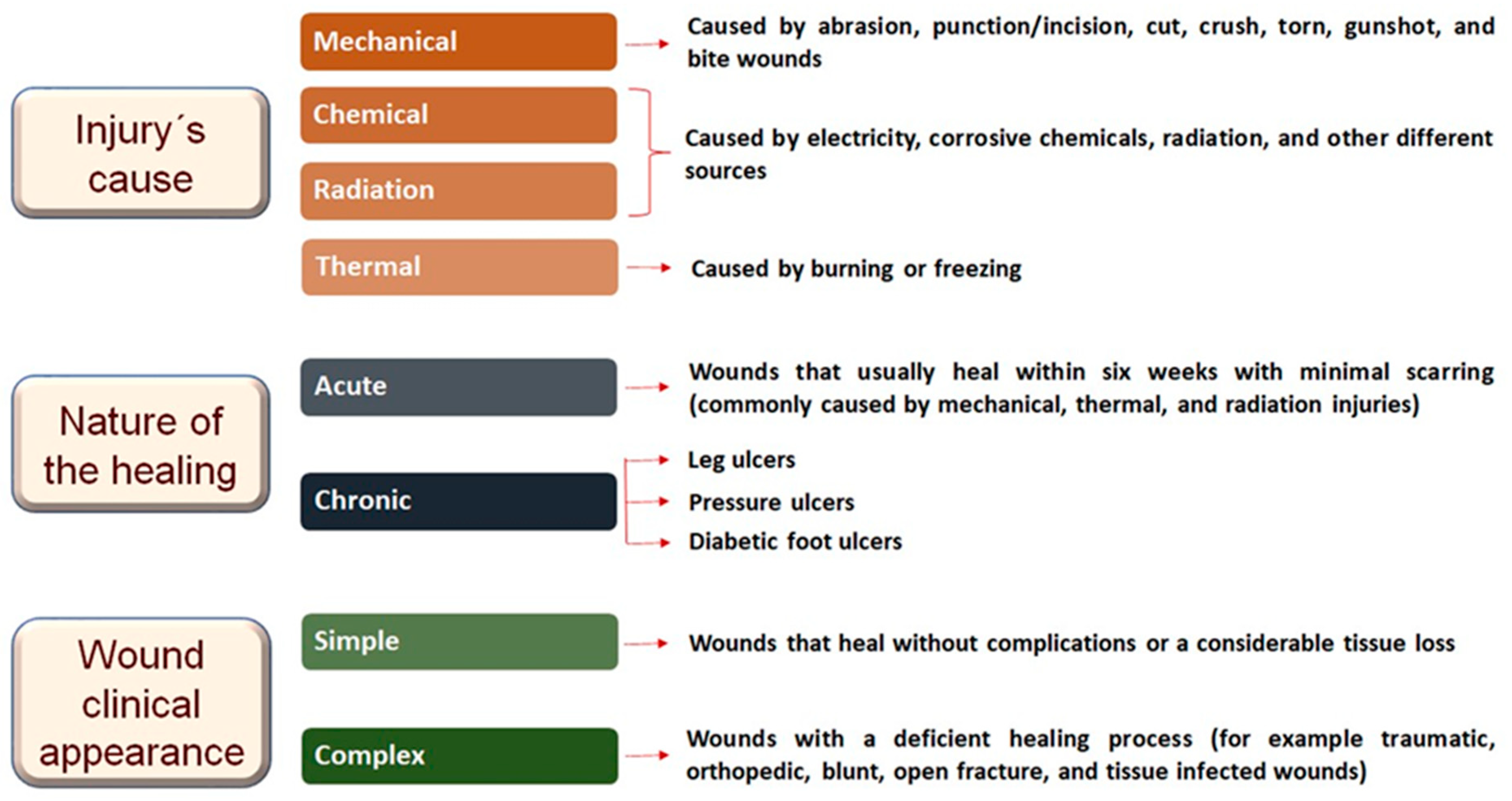
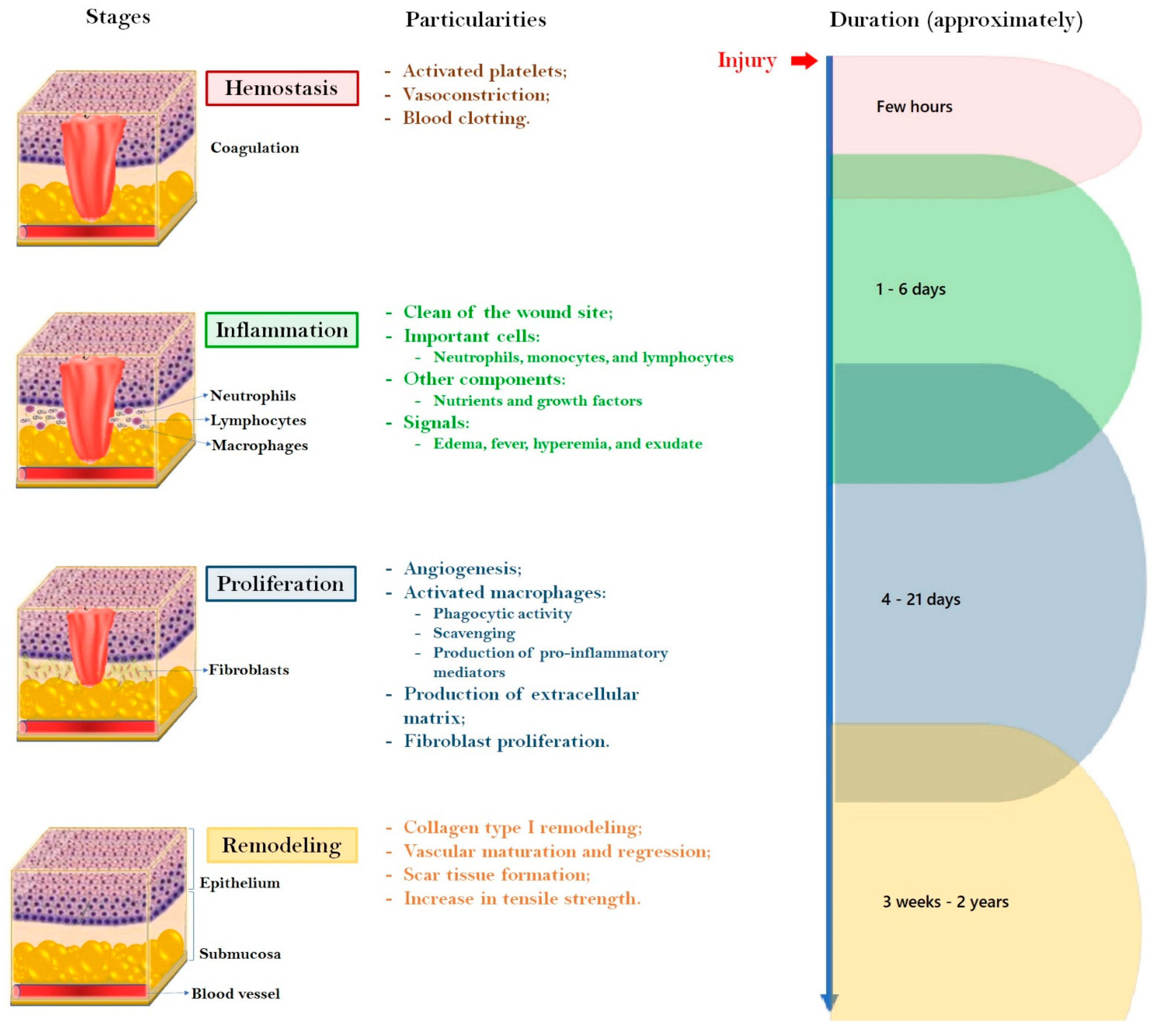
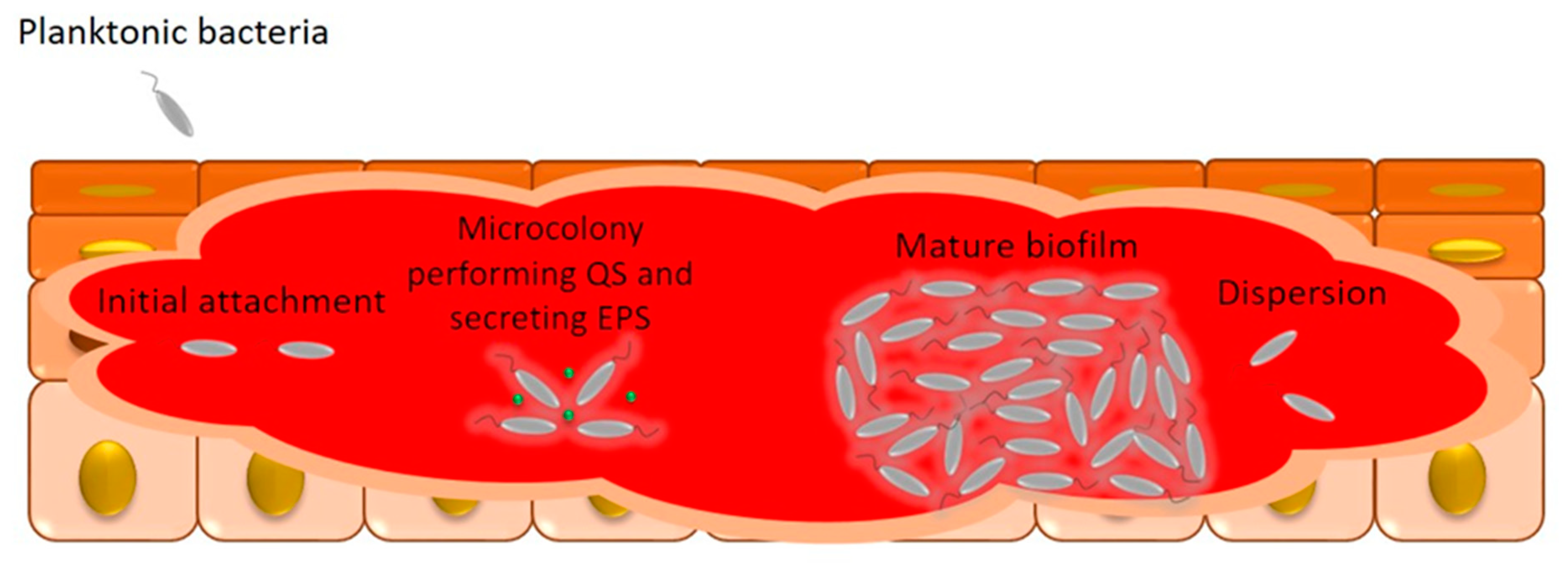
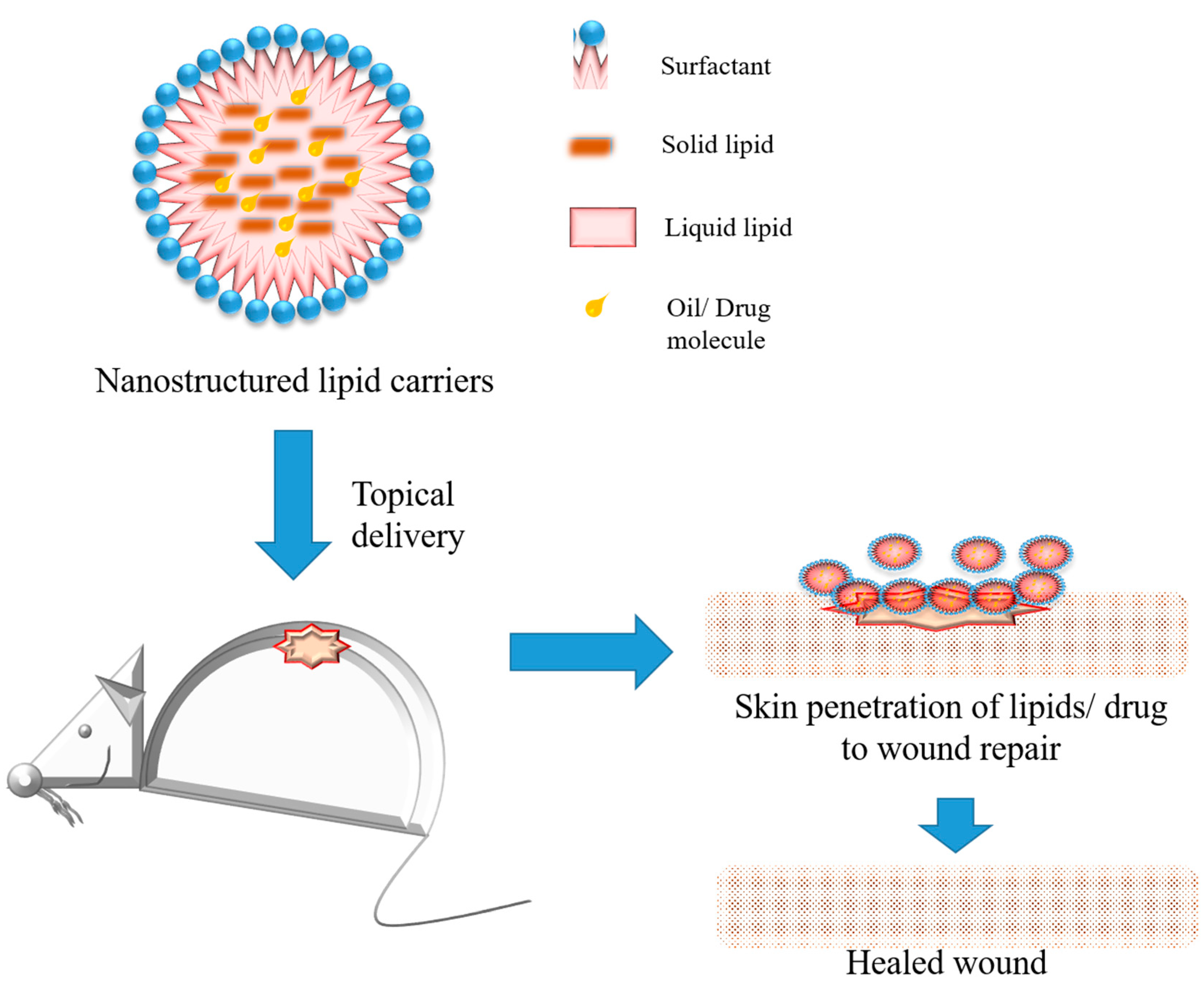
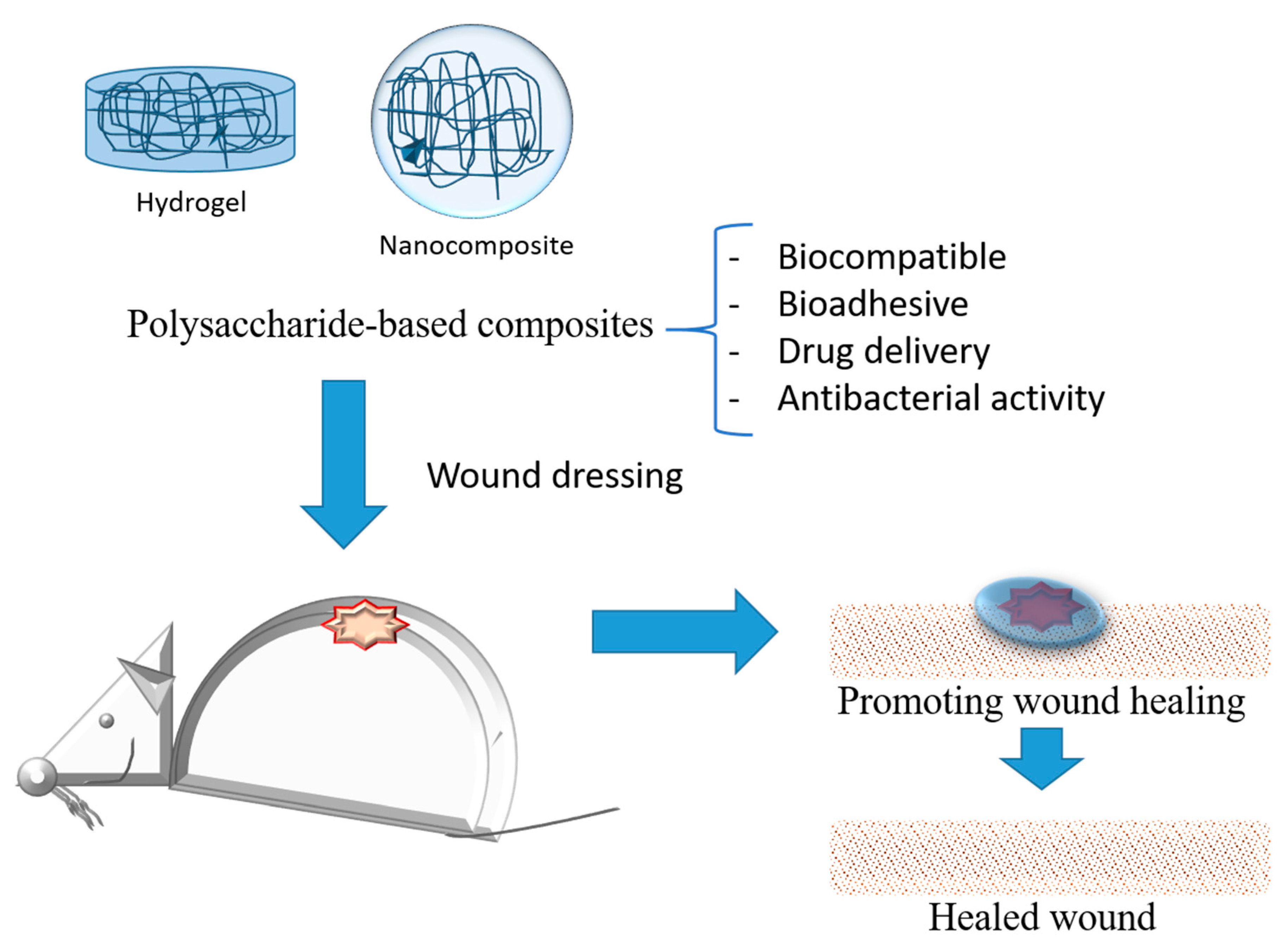
| Source | Formulation | Type of Test and Animal Model | Microorganisms Used for Infection | Reference |
|---|---|---|---|---|
| Proteins | ||||
| Silk sericin (SS) | Hydrogel composed by SS, PVA, AZM, and crosslinked with GNP | In vivo study using an infected mouse full-thickness burn model with a 10% total body surface area | S. aureus, P. aeruginosa, E. coli, and Candida albicans | [49] |
| Bovine serum albumin (BSA) | Hydrogel composed by THPS and BSA | In vivo mice model wound infection (female BALB/c mice) | S. aureus and MRSA | [50] |
| Silk | Silk hydrogel, L-carnosine, and curcumin | In vivo wound healing test using streptozotocin tempted diabetic mice | S. aureus and E. coli | [51] |
| ε-polylysine | hydrogel fabricated with oxidized alginic acid, dopamine, and antimicrobial peptide ε-polylysine crosslinked with acrylamide | In vivo infected full-thickness wound healing test | Gram-positive and gram-negative bacteria | [52] |
| Gelatin | Hydrogels based on gelatin methacrylate (GelMA) and dopamine methacrylate (DMA), both of them immersed into zinc nitrate solutions | In vitro tests on NIH-3T3 cells | E. coli | [53] |
| Gelatin | Gelatin hydrogel incorporated with bio-nanosilver (silver nanoparticles from a spent mushroom substrate) functionalized with lactoferrin (LTF) | In vitro anti-biofilm, antibacterial, and cytotoxicity assays | S. aureus and P. aeruginosa | [54] |
| Collagen | Bilayer membrane composed of collagen, chitosan, Aloe vera, and gelatin | In vivo infected full-thickness wound healing test | Not mentioned | [56] |
| Fibrin | Fibrin hydrogel incorporating BNN6-loaded mesoporous polydopamine nanoparticles | In vivo wound healing test | MRSA | [57] |
| Antimicrobial peptide (AMP) from L. garvieae | Hybrid hydrogel composed of Pluronic F127 (PF127), ethylenediaminetetraacetic acid (EDTA) loaded liposomes, glutathione (GSH), and the AMP from L. garvieae. | In vitro antibacterial and anti-biofilm effects against S. aureus; in vivo treatment of MRSA infected mouse wounds | S. aureus and MRSA | [59] |
| Nisin | Nisin incorporated in a composite hydrogel based on natural polysaccharides [gellan gum (GG) and a mixture of GG and alginate) | In vitro antimicrobial test | S. pyogenes | [61] |
| AMP modified hyaluronic acid (HA-AMP) | Hydrogel prepared with the aldehyde group of oxidized-dextran and the amino group HA-AMP through Schiff´s base formation, and platelet-rich plasma | In vitro antimicrobial test and in vivo infected full-thickness wound healing test (diabetic mouse) | E. coli, S. aureus, and P. aeruginosa | [63] |
| Lipids | ||||
| Virgin coconut oil | Oil | In vivo topical application to treat excision wounds in young rats | Not mentioned | [71] |
| Sunflower/canola oils and canola/linseed oils | Oil blends | In vivo wound healing test in rats | Not mentioned | [74] |
| Sapindus mukorossi seed oil | Hydrogel based on carboxymethyl cellulose (CMC)/hyaluronic acid (HA)/sodium alginate (SA) | In vitro antimicrobial test and in vivo infected full-wound healing test | Propionibacterium acnes, S. aureus, and Candida albicans | [75] |
| Buriti (Mauritia flexuosa L.) oil | Composite chitosan-buriti oil gel | In vitro antimicrobial test and in vivo infected full-wound healing test | S. aureus and Klebsiella pneumoniae | [76] |
| Oil extracted from Opuntia ficus indica L. inermis (OFI) | Oil | In vitro antimicrobial test and in vivo infected full-wound healing test | Enterobacter cloacae, C. parapsilosis, C. shake, Penicillium, Aspergillus, and Fusarium | [78] |
| Cocoa butter (solid lipid) and olive oil (liquid lipid) | Nanostructured lipid carriers based on cocoa butter oil, olive oil, and eucalyptus oils | In vitro wound healing properties towards normal human dermal fibroblasts and in vivo wound healing test on a rat burn model | S. aureus and S. pyogenes | [65] |
| Oleic acid or linoleic acid | Films based on chitosan containing oleic and linoleic acids, and glycerol | In vivo wound healing test on burned patients | - | [84] |
| Thyme oil | Films based on chitosan and thyme oil | In vitro antimicrobial test | E. coli, K. pneumoniae, S. Aureus, and P. aeruginosa | [85] |
| Lipid components of Chamaecyparis obtusa extract | Lipid mixture | In vitro antimicrobial test and in vivo wound healing test | S. aureus and S. pyogenes | [87] |
| Peppermint essential oil (PEO) | Nanostructured lipid carriers loaded with PEO | In vitro antibacterial test and in vivo infected wound healing test (mice model) | S. epidermidis, S. aureus, Lysteria monocytogenes, E. coli, and P. aeruginosa | [88] |
| Fusidic acid | Nanoengineered lipid-polymer hybrid nanoparticle with chitosan encapsulating the fusidic acid | In vitro antibacterial test | MRSA 33,591 and methicillin-susceptible S. aureus (MSSA) 25921 | [89] |
| Fatty acids isolated from the microalgae Spirulina platensis | The lipid extracts from S. platensis were vectorized using a macroalgal-alginate nanocarrier | In vitro anti-biofilm test | Candida species | [90] |
| Carbohydrates | ||||
| Chitosan | Chitosan and Platelet Rich Plasma (PRP) | In vivo infected burn wound test (Wistar rats) | C. albicans | [93] |
| Exopolysaccharide isolated from a marine bacterium Pantoea sp. YU16-S3 | Hydrogel | In vitro biocompatibility test with dermal fibroblasts and keratinocytes and in vivo wound healing test in rats | Not mentioned | [94] |
| Exopolysaccharide produced by Nostoc sp. Strains PCC7936 and PCC7413 | Hydrogel | Wound healing in vitro scratch assay | Not mentioned | [95] |
| Chitosan | Nanoparticles composed by chitosan, poly(N-vinylpyrrolidone) (PVP), and titanium dioxide (TiO2) | In vitro antimicrobial test and in vivo wound healing test (albino rat model) | E. coli, S. aureus, P. aeruginosa, and B. subtilis | [98] |
| Water soluble thymine-modified chitosan (TC) derivatives | TC sponge dressings | In vitro antimicrobial test | gram-negative bacteria, gram-positive bacteria, fungi, drug-resistance bacteria, P. aeruginosa, and Acinetobacter baumannii | [99] |
| Polysaccharide from Pimpinella anisum seeds (PAP) | Gel | In vivo Carrageenan induced paw edema model in mice and topically applied on laser burn lesions | Not mentioned | [100] |
| Hyaluronan (HA) | Hydrogels combining HA in a physically cross-linked alginate | In vivo Rat model of excised wound | Not mentioned | [101] |
| Chitosan and alginate | Hydrogel fabricated with sodium alginate-chitosan oligosaccharide-zinc oxide | In vitro biocompatibility and antimicrobial test | E. coli, S. aureus, C. albicans, and Bacillus subtilis | [104] |
| Chitosan-sulfonamide derivative | Membrane | In vivo study on burn wound model induced in Wistar rats | - | [105] |
| Chitosan and alginate | Hydrogel based on chitosan, alginate, and polyacrylamide | In vitro biocompatibility and antimicrobial test | E. coli and S. aureus | [106] |
| Cellulose and its derivatives | Hydrogel based on the derivatives of cellulose and methacrylated gelatin | In vivo scratch assay wound healing assay and in vivo wound healing test on rats | Not mentioned | [107] |
Disclaimer/Publisher’s Note: The statements, opinions and data contained in all publications are solely those of the individual author(s) and contributor(s) and not of MDPI and/or the editor(s). MDPI and/or the editor(s) disclaim responsibility for any injury to people or property resulting from any ideas, methods, instructions or products referred to in the content. |
© 2023 by the authors. Licensee MDPI, Basel, Switzerland. This article is an open access article distributed under the terms and conditions of the Creative Commons Attribution (CC BY) license (https://creativecommons.org/licenses/by/4.0/).
Share and Cite
de Albuquerque, P.B.S.; Rodrigues, N.E.R.; Silva, P.M.d.S.; de Oliveira, W.F.; Correia, M.T.d.S.; Coelho, L.C.B.B. The Use of Proteins, Lipids, and Carbohydrates in the Management of Wounds. Molecules 2023, 28, 1580. https://doi.org/10.3390/molecules28041580
de Albuquerque PBS, Rodrigues NER, Silva PMdS, de Oliveira WF, Correia MTdS, Coelho LCBB. The Use of Proteins, Lipids, and Carbohydrates in the Management of Wounds. Molecules. 2023; 28(4):1580. https://doi.org/10.3390/molecules28041580
Chicago/Turabian Stylede Albuquerque, Priscilla Barbosa Sales, Natalie Emanuelle Ribeiro Rodrigues, Priscila Marcelino dos Santos Silva, Weslley Felix de Oliveira, Maria Tereza dos Santos Correia, and Luana Cassandra Breitenbach Barroso Coelho. 2023. "The Use of Proteins, Lipids, and Carbohydrates in the Management of Wounds" Molecules 28, no. 4: 1580. https://doi.org/10.3390/molecules28041580
APA Stylede Albuquerque, P. B. S., Rodrigues, N. E. R., Silva, P. M. d. S., de Oliveira, W. F., Correia, M. T. d. S., & Coelho, L. C. B. B. (2023). The Use of Proteins, Lipids, and Carbohydrates in the Management of Wounds. Molecules, 28(4), 1580. https://doi.org/10.3390/molecules28041580







